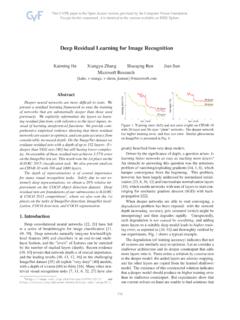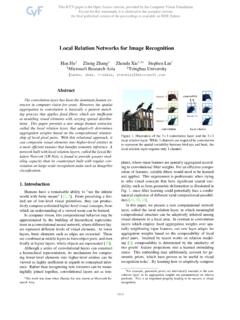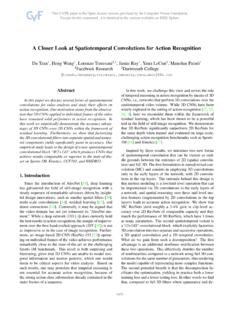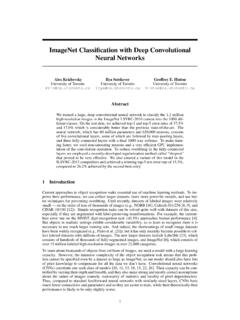Transcription of Faster R-CNN: Towards Real-Time Object Detection with ...
1 1 Faster R-CNN: Towards Real-Time ObjectDetection with Region Proposal NetworksShaoqing Ren, Kaiming He, Ross Girshick, and Jian SunAbstract State-of-the-art Object Detection networks depend on region proposal algorithms to hypothesize Object like SPPnet [1] and Fast R-CNN [2] have reduced the running time of these Detection networks, exposing regionproposal computation as a bottleneck. In this work, we introduce aRegion Proposal Network(RPN) that shares full-imageconvolutional features with the Detection network, thus enabling nearly cost-free region proposals. An RPN is a fully convolutionalnetwork that simultaneously predicts Object bounds and objectness scores at each position. The RPN is trained end-to-end togenerate high-quality region proposals, which are used by Fast R-CNN for Detection .
2 We further merge RPN and Fast R-CNNinto a single network by sharing their convolutional features using the recently popular terminology of neural networks with attention mechanisms, the RPN component tells the unified network where to look. For the very deep VGG-16 model [3],our Detection system has a frame rate of 5fps (including all steps) on a GPU, while achieving state-of-the-art Object detectionaccuracy on PASCAL VOC 2007, 2012, and MS COCO datasets with only 300 proposals per image . In ILSVRC and COCO2015 competitions, Faster R-CNN and RPN are the foundations of the 1st-place winning entries in several tracks. Code has beenmade publicly Terms Object Detection , Region Proposal, Convolutional Neural INTRODUCTIONR ecent advances in Object Detection are driven bythe success of region proposal methods ( , [4])and region-based convolutional neural networks (R-CNNs) [5].
3 Although region-based CNNs were com-putationally expensive as originally developed in [5],their cost has been drastically reduced thanks to shar-ing convolutions across proposals [1], [2]. The latestincarnation, Fast R-CNN [2], achieves near real-timerates using very deep networks [3],when ignoring thetime spent on region proposals. Now, proposals are thetest-time computational bottleneck in state-of-the-artdetection proposal methods typically rely on inex-pensive features and economical inference Search [4], one of the most popular meth-ods, greedily merges superpixels based on engineeredlow-level features. Yet when compared to efficientdetection networks [2], Selective Search is an order ofmagnitude slower, at 2 seconds per image in a CPUimplementation.
4 EdgeBoxes [6] currently provides thebest tradeoff between proposal quality and speed,at seconds per image . Nevertheless, the regionproposal step still consumes as much running timeas the Detection network. S. Ren is with University of Science and Technology of China, Hefei,China. This work was done when S. Ren was an intern at MicrosoftResearch. Email: K. He and J. Sun are with Visual Computing Group, MicrosoftResearch. R. Girshick is with Facebook AI Research. The majority of this workwas done when R. Girshick was with Microsoft Research. may note that fast region-based CNNs takeadvantage of GPUs, while the region proposal meth-ods used in research are implemented on the CPU,making such runtime comparisons inequitable.
5 An ob-vious way to accelerate proposal computation is to re-implement it for the GPU. This may be an effective en-gineering solution, but re-implementation ignores thedown-stream Detection network and therefore missesimportant opportunities for sharing this paper, we show that an algorithmic change computing proposals with a deep convolutional neu-ral network leads to an elegant and effective solutionwhere proposal computation is nearly cost-free giventhe Detection network s computation. To this end, weintroduce novelRegion Proposal Networks(RPNs) thatshare convolutional layers with state-of-the-art objectdetection networks [1], [2]. By sharing convolutions attest-time, the marginal cost for computing proposalsis small ( , 10ms per image ).Our observation is that the convolutional featuremaps used by region-based detectors, like Fast R-CNN, can also be used for generating region pro-posals.
6 On top of these convolutional features, weconstruct an RPN by adding a few additional con-volutional layers that simultaneously regress regionbounds and objectness scores at each location on aregular grid. The RPN is thus a kind of fully convo-lutional network (FCN) [7] and can be trained end-to-end specifically for the task for generating are designed to efficiently predict region pro-posals with a wide range of scales and aspect ratios. Incontrast to prevalent methods [8], [9], [1], [2] that [ ] 6 Jan 20162multiple scaled imagesmultiple filter sizesmultiple references(a)(b)(c)imagefeature mapimagefeature mapimagefeature mapFigure 1: Different schemes for addressing multiple scales and sizes. (a) Pyramids of images and feature mapsare built, and the classifier is run at all scales.
7 (b) Pyramids of filters with multiple scales/sizes are run onthe feature map. (c) We use pyramids of reference boxes in the regression of images (Figure 1, a) or pyramids of filters(Figure 1, b), we introduce novel anchor boxesthat serve as references at multiple scales and aspectratios. Our scheme can be thought of as a pyramidof regression references (Figure 1, c), which avoidsenumerating images or filters of multiple scales oraspect ratios. This model performs well when trainedand tested using single-scale images and thus benefitsrunning unify RPNs with Fast R-CNN [2] Object detec-tion networks, we propose a training scheme thatalternates between fine-tuning for the region proposaltask and then fine-tuning for Object Detection , whilekeeping the proposals fixed.
8 This scheme convergesquickly and produces a unified network with convo-lutional features that are shared between both comprehensively evaluate our method on thePASCAL VOC Detection benchmarks [11] where RPNswith Fast R-CNNs produce Detection accuracy bet-ter than the strong baseline of Selective Search withFast R-CNNs. Meanwhile, our method waives nearlyall computational burdens of Selective Search attest-time the effective running time for proposalsis just 10 milliseconds. Using the expensive verydeep models of [3], our Detection method still hasa frame rate of 5fps (including all steps) on a GPU,and thus is a practical Object Detection system interms of both speed and accuracy.
9 We also reportresults on the MS COCO dataset [12] and investi-gate the improvements on PASCAL VOC using theCOCO data. Code has been made publicly (in MATLAB) (in Python).A preliminary version of this manuscript was pub-lished previously [10]. Since then, the frameworks ofRPN and Faster R-CNN have been adopted and gen-eralized to other methods, such as 3D Object Detection [13], part-based Detection [14], instance segmentation[15], and image captioning [16]. Our fast and effectiveobject Detection system has also been built in com-1. Since the publication of the conference version of this paper[10], we have also found that RPNs can be trained jointly with FastR-CNN networks leading to less training systems such as at Pinterests [17], with userengagement improvements ILSVRC and COCO 2015 competitions, FasterR-CNN and RPN are the basis of several 1st-placeentries [18] in the tracks of ImageNet Detection , Ima-geNet localization, COCO Detection , and COCO seg-mentation.
10 RPNs completely learn to propose regionsfrom data, and thus can easily benefit from deeperand more expressive features (such as the 101-layerresidual nets adopted in [18]). Faster R-CNN and RPNare also used by several other leading entries in thesecompetitions2. These results suggest that our methodis not only a cost-efficient solution for practical usage,but also an effective way of improving Object detec-tion RELATEDWORKO bject is a large literature on objectproposal methods. Comprehensive surveys and com-parisons of Object proposal methods can be found in[19], [20], [21]. Widely used Object proposal methodsinclude those based on grouping super-pixels ( ,Selective Search [4], CPMC [22], MCG [23]) and thosebased on sliding windows ( , objectness in windows[24], EdgeBoxes [6]).



![arXiv:0706.3639v1 [cs.AI] 25 Jun 2007](/cache/preview/4/1/3/9/3/1/4/b/thumb-4139314b93ef86b7b4c2d05ebcc88e46.jpg)
![arXiv:1301.3781v3 [cs.CL] 7 Sep 2013](/cache/preview/4/d/5/0/4/3/4/0/thumb-4d504340120163c0bdf3f4678d8d217f.jpg)
![@google.com arXiv:1609.03499v2 [cs.SD] 19 Sep 2016](/cache/preview/c/3/4/9/4/6/9/b/thumb-c349469b499107d21e221f2ac908f8b2.jpg)







![arXiv:1812.01187v2 [cs.CV] 5 Dec 2018](/cache/preview/c/b/1/2/d/d/5/b/thumb-cb12dd5b147004c786bfda6881481412.jpg)


![Wide Residual Networks arXiv:1605.07146v4 [cs.CV] 14 Jun ...](/cache/preview/f/7/8/5/a/7/7/4/thumb-f785a7744743f4acbd6636c813dabbb6.jpg)
